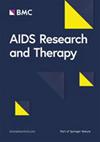Determinants of survival of adolescents receiving antiretroviral therapy in the Centre Region of Cameroon: a multi-centered cohort-analysis
IF 2.1
4区 医学
Q3 INFECTIOUS DISEASES
引用次数: 0
Abstract
In spite of the global decreasing mortality associated with HIV, adolescents living with HIV (ADLHIV) in sub-Saharan Africa still experience about 50% mortality rate. We sought to evaluate survival rates and determinants of mortality amongst ADLHIV receiving antiretroviral therapy (ART) in urban and rural settings. A multi-centered, 10-year retrospective, cohort-study including ADLHIV on ART ≥ 6 months in the urban and rural settings of the Centre Region of Cameroon. Socio-demographic, clinical, biological, and therapeutic data were collected from files of ADLHIV. The Kaplan–Meier method was used to estimate survival probability after ART initiation; the log rank test used to compare survival curves between groups of variables; and the Cox proportional hazard model was used to identify the determinants of mortality. A total of 403 adolescents’ records were retained; 340 (84%) were from the urban and 63 (16%) from the rural settings. The female to male ratio was 7:5; mean age (Standard deviation) was 14.1 (2.6) years; at baseline, 64.4% were at WHO clinical stages I/II, 34.9% had ≥ 500 CD4 cells/mm3, 91.1% were anemic, and the median [Inter Quartile Range] duration on ART was5.3 [0.5–16] years. The survival rate at 1, 5 and 10 years on ART was respectively 97.0%, 55.9% and 8.7%; with mean survival time of 5.8 years (95% CI 5.5–6.1). In bivariate analysis, living in the rural setting, non-disclosed HIV status, baseline CD4 count < 500 cells/mm3, not being exposed to nevirapine prophylaxis at birth and being horizontally infected were found to be the determinants of higher mortality with poor retention in care slightly associated with mortality. In multivariate analysis, living in rural settings, poor retention in care and anemia were independent predictors of mortality (p < 0.05). Although ADLHIV have good survival rate on ART after 1 year, we observe poor survival rates after 5 years and especially 10 years of treatment experience. Mitigating measures against poor survival should target those living in rural settings, anemic at baseline, or experiencing poor retention in care.喀麦隆中部地区接受抗逆转录病毒疗法的青少年存活率的决定因素:多中心队列分析
尽管全球艾滋病相关死亡率不断下降,但撒哈拉以南非洲地区感染艾滋病毒的青少年(ADLHIV)的死亡率仍高达 50%。我们试图评估在城市和农村环境中接受抗逆转录病毒疗法(ART)的 ADLHIV 的存活率和决定死亡率的因素。这是一项为期 10 年的多中心回顾性队列研究,研究对象包括在喀麦隆中部地区的城市和农村环境中接受抗逆转录病毒疗法超过 6 个月的 ADLHIV。研究人员从 ADLHIV 的档案中收集了社会人口学、临床、生物和治疗数据。采用卡普兰-梅耶法估算抗逆转录病毒疗法启动后的生存概率;采用对数秩检验比较变量组间的生存曲线;采用考克斯比例危险模型确定死亡率的决定因素。共保留了 403 份青少年记录,其中 340 份(84%)来自城市,63 份(16%)来自农村。男女比例为 7:5;平均年龄(标准差)为 14.1 (2.6)岁;基线时,64.4% 的青少年处于世界卫生组织临床 I/II 期,34.9% 的青少年 CD4 细胞数≥ 500 个/mm3,91.1% 的青少年贫血,接受抗逆转录病毒疗法时间的中位数[四分位间范围]为 5.3 [0.5-16] 年。接受抗逆转录病毒疗法 1 年、5 年和 10 年的存活率分别为 97.0%、55.9% 和 8.7%,平均存活时间为 5.8 年(95% CI 5.5-6.1)。在双变量分析中发现,生活在农村环境、未披露艾滋病毒感染状况、基线 CD4 细胞计数小于 500 cells/mm3、出生时未接受奈韦拉平预防治疗以及水平感染是导致死亡率升高的决定因素,而护理效果不佳与死亡率略有关联。在多变量分析中,居住在农村地区、接受护理情况不佳和贫血是死亡率的独立预测因素(p < 0.05)。虽然 ADLHIV 在接受抗逆转录病毒疗法 1 年后的存活率较高,但我们发现在接受治疗 5 年,尤其是 10 年后的存活率较低。针对存活率低的缓解措施应针对那些生活在农村地区、基线贫血或治疗效果不佳的患者。
本文章由计算机程序翻译,如有差异,请以英文原文为准。
求助全文
约1分钟内获得全文
求助全文
来源期刊

AIDS Research and Therapy
INFECTIOUS DISEASES-
CiteScore
3.80
自引率
4.50%
发文量
51
审稿时长
16 weeks
期刊介绍:
AIDS Research and Therapy publishes articles on basic science, translational, clinical, social, epidemiological, behavioral and educational sciences articles focused on the treatment and prevention of HIV/AIDS, and the search for the cure. The Journal publishes articles on novel and developing treatment strategies for AIDS as well as on the outcomes of established treatment strategies. Original research articles on animal models that form an essential part of the AIDS treatment research are also considered
 求助内容:
求助内容: 应助结果提醒方式:
应助结果提醒方式:


